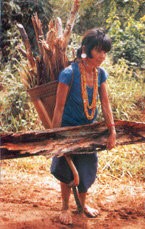The Stieng people live on the Vietnamese border between Memut in Kompong Cham province, Snoul in Kratie province and Kao Sema in the Mondolkiri province. There are approximately 6,000 Stieng in Cambodia, and nearly 50,000 in Vietnam. They speak two distinct dialects: Budip and Bulo.
The majority of the Stieng live near Snoul, Kratie, in Cambodia. During the French colonial days, the Stieng enjoyed much autonomy in Indochina. When the post-colonial borders were drawn the minority groups' villages were not considered hence the border was drawn right through the Stieng ancestral territory. Today most Stieng have relatives on both sides of the Vietnamese-Cambodian border. During the Vietnam war, the Stieng area was a hotbed of military activity. It was in the Stieng region where the Americans invaded and where B-52 carpet bombing was centered. Nearly every Stieng family lost multiple family members in the war between the USA and Vietnam. Under the Khmer Rouge, the Stieng were often considered American spies and again faced much harsh treatment and persecution. On 2 December 1978 when the Khmer and Vietnamese forces invaded to topple the Khmer Rouge, the first invasion was launched in Snoul.
Most of the Stieng do not grow rice, but rather have plantations. In these plantations black pepper, cashew nuts and durian are the main crops. They also rely heavily on hunting and wood cutting in the jungles around their homes. Most Stieng still live in traditional houses which are made from the leaves of palm trees. The roof structures are quite different from those of other tribes, thus their houses are easily recognizable. Because the Stieng live very close, or even inter-mingle with the Khmer, they are often indistinguishable by the untrained eye.
The Stieng, like all peoples of Cambodia, are highly animistic. While some have adopted Khmer Buddhism, others retain purely animistic practices. There are approximately 1,000 Stieng Christians in Cambodia, with many thousands of Christians in Vietnam. Indeed, the Gospel entered the Stieng area in Cambodia in the late 1980s and early 1990s through Vietnamese-Stieng evangelists. Today, all the Stieng pastors became Christians through crossborder inter-tribe evangelism.
The Stieng have never been appreciated or respected. They live in close proximity to other majority groups such as the Khmer, Vietnamese and Cham and therefore most speak fluent Khmer. They still, however, seek to retain the use of their language at home. The current "land-rush" in Cambodia has cost the Stieng once again as they are forced to leave their ancestral lands, having whole sections of the jungle given to private companies. It is on this jungle that they have made their livelihood for generations There is no education in the Stieng language, and most purely Stieng villages do not have schools or medical facilities available. Therefore, education is a primary need.
Scripture Prayers for the Stieng, Bulo in Vietnam.
| Profile Source: Cambodia Research Network. Click to email CRN inquiries and corrections Copyrighted © Used with permission |










